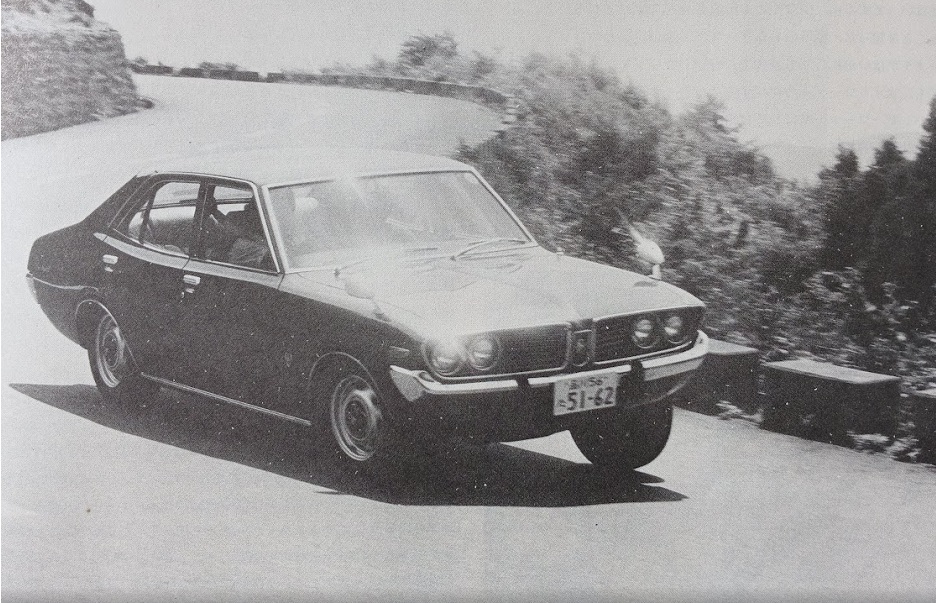Toyota Corona Mark II LG (1973)

Publication: Car Graphic
Format: From Our Motoring Diaries
Date: November 1973
Author: “C/G Test Group” (uncredited)
Road testing the Toyota Corona Mark II LG
Even the C/G staff sometimes just wants to relax and enjoy a cruise while listening to music. In this scenario, American cars are ideal, with spacious interiors, good quality seats, the comfort of air conditioning, quiet and powerful engines combined with automatic transmissions, and power-assisted steering that requires no mental or physical effort. If they also had good quality AM/FM radios, they would be perfect. Some of the only domestic cars that fit this criteria are the luxurious four-door sedans of the Laurel and Mark II series, and among these, the Corona Mark II LG Automatic is one of the best.
As the top-end model of the Mark II range, introduced after the minor change in August of this year, the LG’s selling point is that it is the first domestically produced sedan with a six-cylinder engine to adopt electronically controlled fuel injection (although it is basically the same EFI system available on the four-cylinder Mark II). This feature has become the car’s greatest merit. In particular, starting ability and operation at low temperatures have been dramatically improved. The engine wakes up immediately with a twist of the ignition key, regardless of the outside air temperature and internal water temperature, and it settles into an even, steady idle of 1000rpm when cold and 800rpm when warm.
Even if you immediately put the floor-mounted selector in “D” and drive off into crowded city traffic, the EFI-equipped six-cylinder responds without hesitation. This can be quite astonishing to those who experienced the worst of the old auto-choke and automatic-transmission combinations. In those days, unless you waited until the water temperature had risen sufficiently and the idle had settled down, you often had to endure the engine’s agonizing lurching as soon as you put the selector into “D,” or stalling every time you stopped at a traffic light (not to mention that auto chokes also start to malfunction after about the second year).
When we drove around town and made a conscious effort to rev up the engine (upshifts occur at very low rpm when driving normally in D, so there is rarely a chance to rev it up), we noticed that it was a little quieter and smoother at the top end than before. This is the advantage of sharing an engine with the Crown, because the improvements made during the Crown’s minor change were carried over to the Mark II, and this engine now belongs in the best category of domestically produced six-cylinder engines.
This superior smoothness and low noise in the high rotation range are the six-cylinder Mark II’s biggest advantage over the four-cylinder with the same 2-liter displacement. However, in terms of the power increase due to the installation of EFI (135ps compared to 115ps for the single-carburetor engine), it was not so noticeable when combined with the Aisin Warner automatic transmission. Therefore, there was no significant difference in power performance or automatic transmission performance from the previously tested model (see C/G April 1972 issue), and the same could be said for the standard power steering.
The roominess and ride comfort are no different from the single-carburetor L series. The seats are large, soft, and spacious, and the ride has the so-called “heavy” feeling that is characteristic of Toyota’s small cars. However, the wide radial tires that were installed on the test car, 185/70HR-14 Bridgestone RD105 Wide 70s, clearly spoiled the ride. Especially when set to the specified high-speed pressure of 2.0/2.0kg/cm², the stiffness typical of radial tires is clearly apparent, and on rough roads, bumps punch through with a bang. If you switch back to the standard 6.45S-14 bias-ply tires, the ride should be much more comfortable, and it should have no affect on maneuverability at speeds that average owners will drive.
Therefore, as long as it is equipped with bias-ply tires, this car is a perfectly good cruiser when driving on well-paved roads in the flow of traffic. The engine is smooth and quiet, the automatic transmission and power steering make driving effortless (although the brake pedal is still high off the floor, which is a pain), and you can even order air conditioning and power windows if you want them. And for a short time, we enjoyed cruising and listening to the FM radio. However, as soon as we entered the mountain roads near Hakone, we realized that this car was not suitable for high-speed driving, at least not on these kinds of roads. The suspension, tuned the same as the standard L-series, has excessive roll and understeer, and even with the help of the light power steering, it is not good at roads with a series of tight corners. Also, as is often the case with Toyota cars, it floats around in bumpy turns, and the tail slides out relatively easily in tight corners, even with the wide radial tires. However, it is acceptably fast on roads with shallow curves and gentle ups and downs like the Izu Skyline.
One of the advantages of EFI is the fuel economy, which was 6.98km/l on our round trip to Hakone via the Tomei Expressway, about 10% better than a Mark II L sedan with an automatic transmission that we drove under nearly identical conditions. However, if you drive on the congested streets of Tokyo, the worst case scenario will be less than 4km/l. The standard price of the test car in Tokyo is 1,123,000 yen (with bias-ply tires), but if you add air conditioning, power windows, and a cruise control system that automatically maintains a pre-set speed, the price will be close to 1,300,000 yen. Still, some people may consider it a cheap purchase, since it is a reasonable size and not that different in content from an American car.